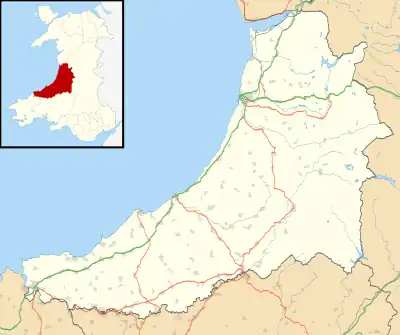| Capel Eidalwyr | |
|---|---|
.jpg.webp) "an unique and unusually elaborate example" | |
 Capel Eidalwyr Location in Ceredigion | |
| 52°02′08″N 4°23′50″W / 52.0356°N 4.3972°W | |
| Location | Henllan, Ceredigion |
| Country | Wales |
| Denomination | Roman Catholic |
| History | |
| Founded | c.1940 |
| Architecture | |
| Functional status | Redundant |
| Architectural type | Chapel |
| Style | Vernacular |
Listed Building – Grade II* | |
| Official name | Capel Eidalwyr |
| Designated | 4 June 1996 |
| Reference no. | 17608 |
Capel Eidalwyr is a Roman Catholic chapel located on the site of a prisoner-of-war camp at Henllan, Ceredigion, Wales. The chapel was established in a former dormitory by Italian prisoners of war, and was decorated mainly by Mario Felito. Now disused, and in some disrepair, the chapel is a Grade II* listed building, described in its Cadw record as "an unique and unusually elaborate example".
History
The chapel was the inspiration of Don Ital Padoan, a priest interned at Henllan.[1] Given permission by the camp authorities to convert a Nissen hut previously in use as a dormitory, the prisoners used readily-available materials, including wood from packing cases, empty tinned-food containers, roofing felt and cement bags. Paint was extracted from natural dyes[2] and the painting was principally undertaken by Mario Felito. The chapel was formally dedicated in 1944.[3]
Felito returned to the camp with seven other former prisoners in 1977.[4][lower-alpha 1] As of 2020, the chapel has been weather-proofed through complete enclosure within a larger structure and restoration is ongoing.[5] The chapel is open for visits by prior appointment.[6]
Architecture and description
Thomas Lloyd, Julian Orbach and Robert Scourfield, in their Carmarthenshire and Ceredigion volume of the Pevsner Buildings of Wales series, consider the interior decoration of the chapel, "the most remarkable home-made Baroque crafted of scrap materials."[7] The apse is decorated with a fresco of the Last Supper, and the walls with roundels illustrated in a Baroque style.[8] Further decoration is provided by concrete wall mouldings, scraped and painted to resemble marble.[7] Capel Eidalwyr is a Grade II* listed building, its Cadw record describing it as “an unique and unusually elaborate example of a P.O.W. Chapel in Wales”.[9]
Gallery
.jpg.webp) The former Prisoner of War Camp, Henllan
The former Prisoner of War Camp, Henllan.jpg.webp) Interior of the chapel
Interior of the chapel
Notes
References
- ↑ "Camp 70 - Henllan Bridge Camp". WW2 UK POW records. Retrieved 13 November 2022.
- ↑ "Henllan Prisoner of War chapel". Peoples Collection Wales. Retrieved 13 November 2022.
- ↑ "Capel Eidalwyr, Henllan Bridge Prisoner of War Camp (301814)". Coflein. RCAHMW. Retrieved 13 November 2022.
- 1 2 "Henllan POW Camp – Church of the Sacred Heart". Llansawel Village website. Retrieved 13 November 2022.
- ↑ McFadden, Brendan (25 August 2019). "Ugly industrial estate tin box that has a breathtakingly beautiful secret inside". The Mirror. Retrieved 13 November 2022.
- ↑ "Henllan P.O.W. Camp 70". UK POW Camp Records. Retrieved 13 November 2022.
- 1 2 Lloyd, Orbach & Scourfield 2006, pp. 479–480.
- ↑ Cooper, John (25 August 2019). "The ugly tin box that has a secret and breathtakingly beautiful chapel inside". WalesOnline. Retrieved 13 November 2022.
- ↑ Cadw. "Former P.O.W. Chapel at Henllan Caravan Park (Grade II*) (17608)". National Historic Assets of Wales. Retrieved 13 November 2022.
Sources
- Lloyd, Thomas; Orbach, Julian; Scourfield, Robert (2006). Carmarthenshire and Ceredigion. The Buildings of Wales. New Haven, US and London: Yale University Press. ISBN 978-0-300-10179-9.